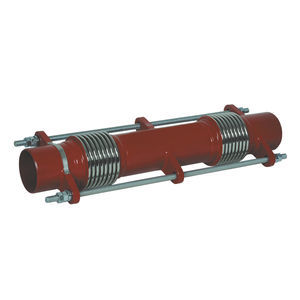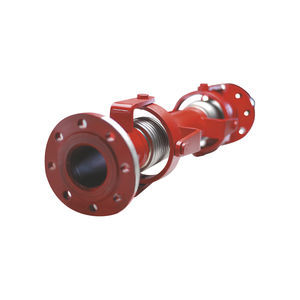
- Hydraulics - Pneumatics
- Pipe, Tube and Fitting
- Metal pipe expansion joint
- Totalien Endustriyel Urunler Sanayi limited Sirketi
Metal pipe expansion joint roundflangeaxial


Add to favorites
Compare this product
Characteristics
- Material
- metal
- Configuration
- round
- Installation system
- flange
- Expansion axis
- axial
- Nominal diameter
Min.: 25 mm
(0.98 in)Max.: 1,200 mm
(47.24 in)- Operating temperature
Min.: -20 °C
(-4 °F)Max.: 400 °C
(752 °F)- Pressure
Min.: 2.5 bar
(36.3 psi)Max.: 64 bar
(928.2 psi)
Description
Externally pressurized expansion joints are also known as X-Pressed Expansion Joints are used that required large thermal expansions (axial compression or axial extension). For these large expansion values standard axial expansion joints are not enough to compensate. Externally pressurized expansion joints are excellent solutions to absorb large movements in the system. Totflex externally pressurized expansion joints are designed that the flow media pressure acts on the outside of the bellows and this external pressure causing stabilizing effect. This stabilizing effect increases the bellows ability to compensate large amount of axial movements (axial compression or axial extension) without increasing the convolution number.
Application Area of X-Pressed Expansion Joints
Buried & Underground Pipelines
Steam Plants
Industrial Cooling Systems
Vertical Pipeline Applications
Geothermal Facilities
Thermal Oil Lines
Structure & Operating Conditions
Bellow Material - Stainless Steel AISI304 (Opt. AISI316 – AISI321)
Pipe Material - Carbon Steel St37.2 (Opt. Stainless Steel)
Connection Types - Fixed & Loose Flanged and Weld Neck
Flange Material - Carbon Steel St37.2 (Opt. Stainless Steel)
Design Standard - EJMA Standards
Catalogs
No catalogs are available for this product.
See all of Totalien Endustriyel Urunler Sanayi limited Sirketi‘s catalogsOther Totalien Endustriyel Urunler Sanayi limited Sirketi products
METAL EXPANSION JOINTS
Related Searches
- Piping
- Structure hose
- Flexible hose
- Water hose
- Steel hose
- Pipe expansion joint
- Round pipe expansion joint
- Stainless steel hose
- Flange pipe expansion joint
- Rubber pipe expansion joint
- Metal pipe expansion joint
- Special hose
- Fire hose
- Axial pipe expansion joint
- Water pipe expansion joint
- Pipe pipe expansion joint
- Heating pipe expansion joint
- Universal pipe expansion joint
- Flexible pipe expansion joint
- Threaded hose
*Prices are pre-tax. They exclude delivery charges and customs duties and do not include additional charges for installation or activation options. Prices are indicative only and may vary by country, with changes to the cost of raw materials and exchange rates.






